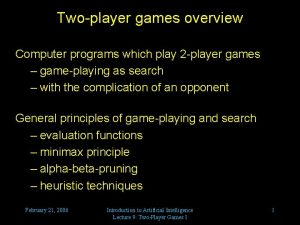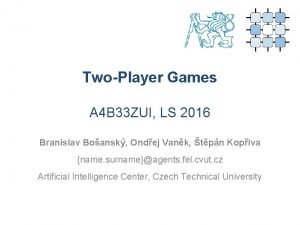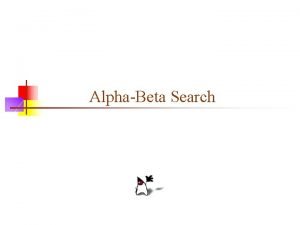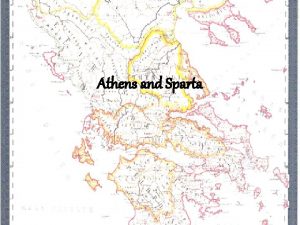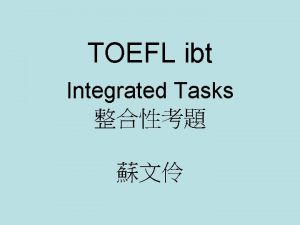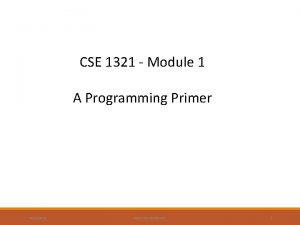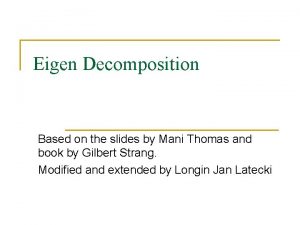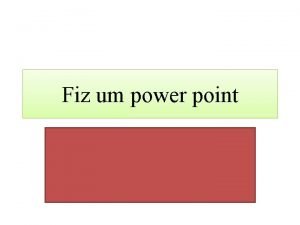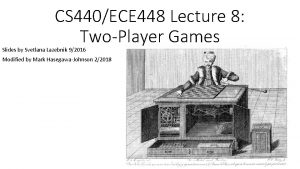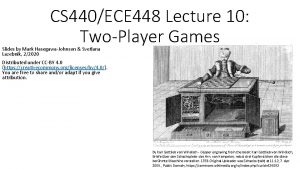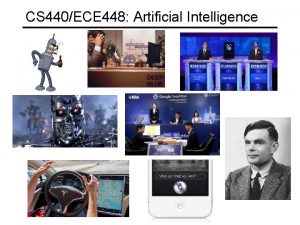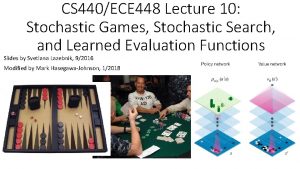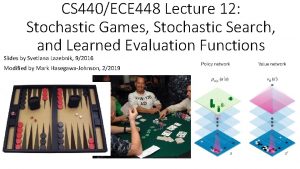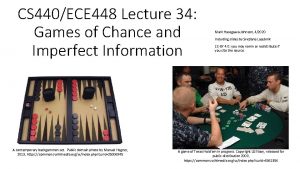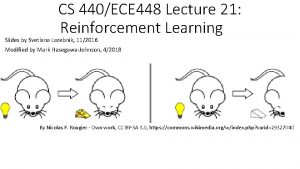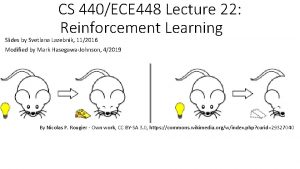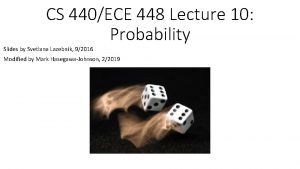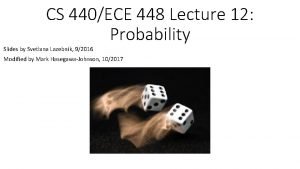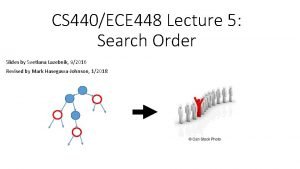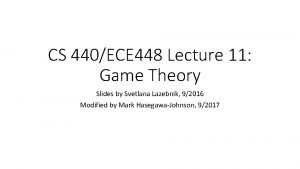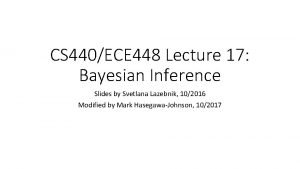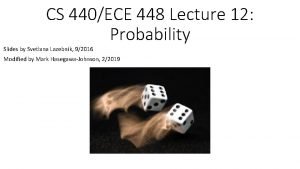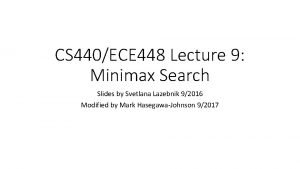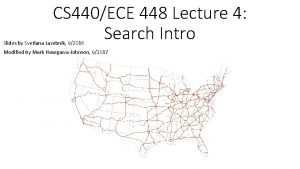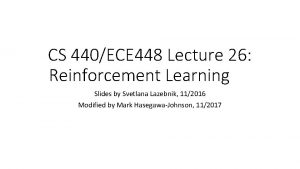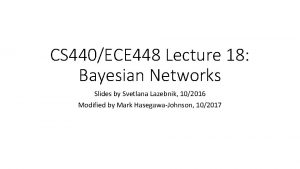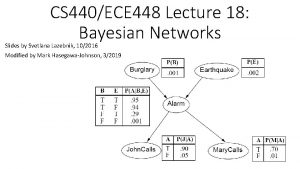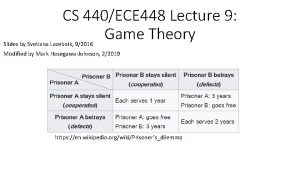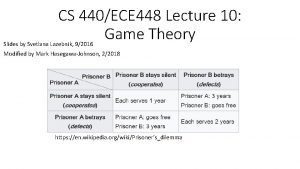CS 440ECE 448 Lecture 8 TwoPlayer Games Slides






































- Slides: 38

CS 440/ECE 448 Lecture 8: Two-Player Games Slides by Svetlana Lazebnik 9/2016 Modified by Mark Hasegawa-Johnson 2/2019

Why study games? • Games are a traditional hallmark of intelligence • Games are easy to formalize • Games can be a good model of real-world competitive or cooperative activities • Military confrontations, negotiation, auctions, etc.

Game AI: Origins • Minimax algorithm: Ernst Zermelo, 1912 • Chess playing with evaluation function, quiescence search, selective search: Claude Shannon, 1949 (paper) • Alpha-beta search: John Mc. Carthy, 1956 • Checkers program that learns its own evaluation function by playing against itself: Arthur Samuel, 1956

Types of game environments Deterministic Perfect Chess, checkers, information (fully observable) go Battleship Imperfect information (partially observable) Stochastic Backgammon, monopoly Scrabble, poker, bridge

Zero-sum Games

Alternating two-player zero-sum games • Players take turns • Each game outcome or terminal state has a utility for each player (e. g. , 1 for win, 0 for loss) • The sum of both players’ utilities is a constant

Games vs. single-agent search • We don’t know how the opponent will act • The solution is not a fixed sequence of actions from start state to goal state, but a strategy or policy (a mapping from state to best move in that state)

Game tree • A game of tic-tac-toe between two players, “max” and “min”

http: //xkcd. com/832/

A more abstract game tree Terminal utilities (for MAX) A two-ply game

Minimax Search

The rules of every game • Every possible outcome has a value (or “utility”) for me. • Zero-sum game: if the value to me is +V, then the value to my opponent is –V. • Phrased another way: • My rational action, on each move, is to choose a move that will maximize the value of the outcome • My opponent’s rational action is to choose a move that will minimize the value of the outcome • Call me “Max” • Call my opponent “Min”

Game tree search 3 3 2 2 • Minimax value of a node: the utility (for MAX) of being in the corresponding state, assuming perfect play on both sides • Minimax strategy: Choose the move that gives the best worst-case payoff

Computing the minimax value of a node 3 3 2 2 • Minimax(node) = § Utility(node) if node is terminal § maxaction Minimax(Succ(node, action)) if player = MAX § minaction Minimax(Succ(node, action)) if player = MIN

Optimality of minimax • The minimax strategy is optimal against an optimal opponent • What if your opponent is suboptimal? • Your utility will ALWAYS BE HIGHER than if you were playing an optimal opponent! • A different strategy may work better for a sub-optimal opponent, but it will necessarily be worse against an optimal opponent 11 Example from D. Klein and P. Abbeel

More general games 4, 3, 2 • • 1, 5, 2 7, 4, 1 1, 5, 2 7, 7, 1 More than two players, non-zero-sum Utilities are now tuples Each player maximizes their own utility at their node Utilities get propagated (backed up) from children to parents

Alpha-Beta Pruning

Alpha-beta pruning • It is possible to compute the exact minimax decision without expanding every node in the game tree

Alpha-beta pruning • It is possible to compute the exact minimax decision without expanding every node in the game tree 3 3

Alpha-beta pruning • It is possible to compute the exact minimax decision without expanding every node in the game tree 3 3 2

Alpha-beta pruning • It is possible to compute the exact minimax decision without expanding every node in the game tree 3 3 2 14

Alpha-beta pruning • It is possible to compute the exact minimax decision without expanding every node in the game tree 3 3 2 5

Alpha-beta pruning • It is possible to compute the exact minimax decision without expanding every node in the game tree 3 3 2 2

Alpha-Beta Pruning Key point that I find most counter-intuitive: • MIN needs to calculate which move MAX will make. • MAX would never choose a suboptimal move. • So if MIN discovers that, at a particular node in the tree, she can make a move that’s REALLY GOOD for her… • She can assume that MAX will never let her reach that node. • … and she can prune it away from the search, and never consider it again.

Alpha-beta pruning • α is the value of the best choice for the MAX player found so far at any choice point above node n • More precisely: α is the highest number that MAX knows how to force MIN to accept • We want to compute the MIN-value at n • As we loop over n’s children, the MIN-value decreases • If it drops below α, MAX will never choose n, so we can ignore n’s remaining children

Alpha-beta pruning • β is the value of the best choice for the MIN player found so far at any choice point above node n • More precisely: β is the lowest number that MIN know how to force MAX to accept • We want to compute the MAX-value at m • As we loop over m’s children, the MAX-value increases • If it rises above β, MIN will never choose m, so we can ignore m’s remaining children β m

Alpha-beta pruning • β m

Alpha-beta pruning Function action = Alpha-Beta-Search(node) v = Min-Value(node, −∞, ∞) return the action from node with value v α: best alternative available to the Max player β: best alternative available to the Min player node action Function v = Min-Value(node, α, β) if Terminal(node) return Utility(node) v = +∞ for each action from node v = Min(v, Max-Value(Succ(node, action), α, β)) if v ≤ α return v β = Min(β, v) end for return v Succ(node, action) …

Alpha-beta pruning Function action = Alpha-Beta-Search(node) v = Max-Value(node, −∞, ∞) return the action from node with value v α: best alternative available to the Max player β: best alternative available to the Min player node action Function v = Max-Value(node, α, β) if Terminal(node) return Utility(node) v = −∞ for each action from node v = Max(v, Min-Value(Succ(node, action), α, β)) if v ≥ β return v α = Max(α, v) end for return v Succ(node, action) …

Alpha-beta pruning • Pruning does not affect final result • Amount of pruning depends on move ordering • Should start with the “best” moves (highest-value for MAX or lowest-value for MIN) • For chess, can try captures first, then threats, then forward moves, then backward moves • Can also try to remember “killer moves” from other branches of the tree • With perfect ordering, the time to find the best move is reduced to O(bm/2) from O(bm) • Depth of search is effectively doubled

Limited-Horizon Computation

Games vs. single-agent search • We don’t know how the opponent will act • The solution is not a fixed sequence of actions from start state to goal state, but a strategy or policy (a mapping from state to best move in that state)

Games vs. single-agent search • We don’t know how the opponent will act • The solution is not a fixed sequence of actions from start state to goal state, but a strategy or policy (a mapping from state to best move in that state) • Efficiency is critical to playing well • The time to make a move is limited • The branching factor, search depth, and number of terminal configurations are huge • In chess, branching factor ≈ 35 and depth ≈ 100, giving a search tree of 10154 nodes • Number of atoms in the observable universe ≈ 1080 • This rules out searching all the way to the end of the game

Evaluation function • Cut off search at a certain depth and compute the value of an evaluation function for a state instead of its minimax value • The evaluation function may be thought of as the probability of winning from a given state or the expected value of that state • A common evaluation function is a weighted sum of features: Eval(s) = w 1 f 1(s) + w 2 f 2(s) + … + wn fn(s) • For chess, wk may be the material value of a piece (pawn = 1, knight = 3, rook = 5, queen = 9) and fk(s) may be the advantage in terms of that piece • Evaluation functions may be learned from game databases or by having the program play many games against itself

Cutting off search • Horizon effect: you may incorrectly estimate the value of a state by overlooking an event that is just beyond the depth limit • For example, a damaging move by the opponent that can be delayed but not avoided • Possible remedies • Quiescence search: do not cut off search at positions that are unstable – for example, are you about to lose an important piece? • Singular extension: a strong move that should be tried when the normal depth limit is reached

Advanced techniques • Transposition table to store previously expanded states • Forward pruning to avoid considering all possible moves • Lookup tables for opening moves and endgames

Chess playing systems Baseline system: 200 million node evalutions per move (3 min), minimax with a decent evaluation function and quiescence search • 5 -ply ≈ human novice • Add alpha-beta pruning • 10 -ply ≈ typical PC, experienced player • Deep Blue: 30 billion evaluations per move, singular extensions, evaluation function with 8000 features, large databases of opening and endgame moves • 14 -ply ≈ Garry Kasparov • More recent state of the art (Hydra, ca. 2006): 36 billion evaluations per second, advanced pruning techniques • 18 -ply ≈ better than any human alive? •

Summary • A zero-sum game can be expressed as a minimax tree • Alpha-beta pruning finds the correct solution. In the best case, it has half the exponent of minimax (can search twice as deeply with a given computational complexity). • Limited-horizon search is always necessary (you can’t search to the end of the game), and always suboptimal. • Estimate your utility, at the end of your horizon, using some type of learned utility function • Quiescence search: don’t cut off the search in an unstable position (need some way to measure “stability”) • Singular extension: have one or two “super-moves” that you can test at the end of your horizon
 Twoplayer games
Twoplayer games Twoplayer games
Twoplayer games Zui games
Zui games Nnn games
Nnn games A small child slides down the four frictionless slides
A small child slides down the four frictionless slides Starting from rest a marble first rolls down
Starting from rest a marble first rolls down Principles of economics powerpoint lecture slides
Principles of economics powerpoint lecture slides Machine learning lecture slides
Machine learning lecture slides Business communication lecture slides
Business communication lecture slides 01:640:244 lecture notes - lecture 15: plat, idah, farad
01:640:244 lecture notes - lecture 15: plat, idah, farad Cs 448
Cs 448 448 scmw
448 scmw Fpga software
Fpga software Ece 448
Ece 448 500 - 448
500 - 448 Factors of 448
Factors of 448 Jest głównym dopływem wisły ma 448 km długości
Jest głównym dopływem wisły ma 448 km długości Ece448
Ece448 Ece448
Ece448 Cs 448
Cs 448 Ece 448
Ece 448 Ece 448
Ece 448 Info 448
Info 448 Chapter 5 hunger games questions
Chapter 5 hunger games questions Types of games indoor and outdoor
Types of games indoor and outdoor Toffle slides
Toffle slides Slides termologia
Slides termologia 37th pauri of japji sahib
37th pauri of japji sahib Caráter significado
Caráter significado Cse 1321 slides
Cse 1321 slides Ria slides
Ria slides Risk workshop slides
Risk workshop slides Purpose driven church powerpoint slides
Purpose driven church powerpoint slides Eigenvalue decomposition
Eigenvalue decomposition Fyp 1
Fyp 1 Slide nr 18
Slide nr 18 Vanguardas europeias slides
Vanguardas europeias slides Dr steven copp
Dr steven copp Papa bear slides
Papa bear slides

